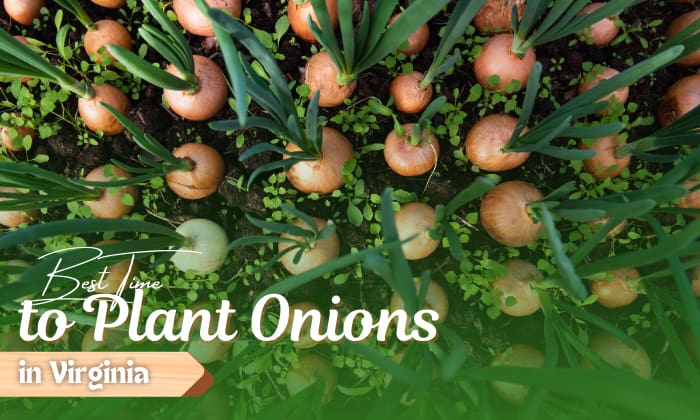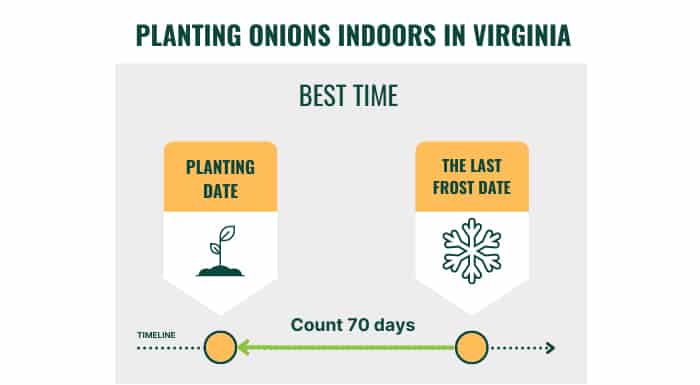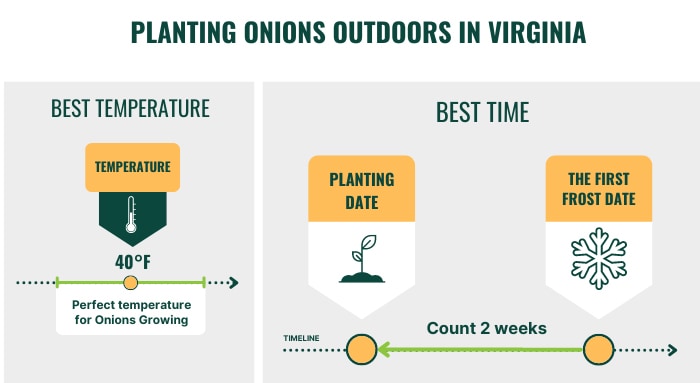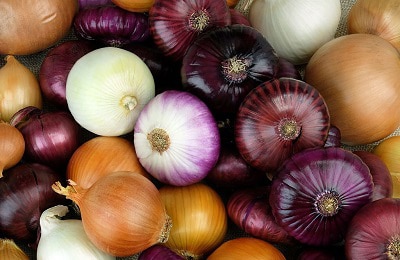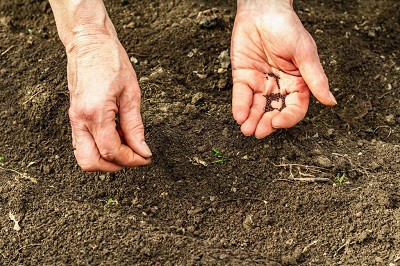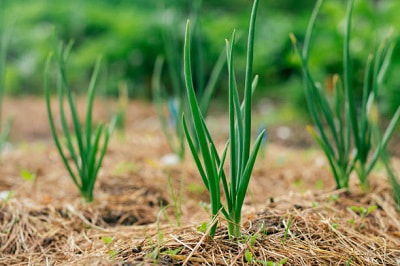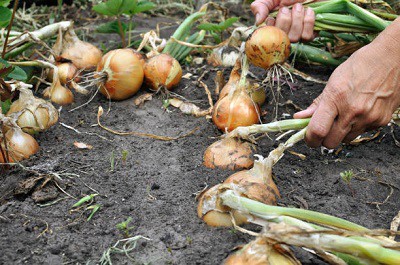Depending on the Virginia growing zone (Virginia is divided into 5 zones), planting time for onions can vary from early March to mid-April.
The section below answers the question, when to plant onions in Virginia according to different zones, but as a standard rule, ensure a gap of two weeks between the planting date and frost date.
Table of Contents
Best Time to Plant Onions in Virginia
1. Depending on the zone
Variation in geographic topography is the reason for different onion growing zones in Virginia.

The zone-wise breakup of onion planting time in Virginia is as follows
| Hardiness Zone | Time to plant Onion |
| Zone 5 | 16th April |
| Zone 6 | 7th April |
| Zone 7 | 20th March |
| Zone 8 | 1st March |
Apart from the zones, the planting times change depending on whether you are planting onions outdoors or indoors.
2. Planting Onions Indoors:
An economical way to plant onions is to first plant seeds indoors at least 70 days before the last frost date (refer table below). When you grow onions from seeds, simply placing them outside one fine day isn’t the right approach. Instead, start exposing them to sunlight approximately 5 weeks before the outdoor planting date.
Initially, expose plants to 1 hour of sunlight daily for 4 weeks, and after that, increase duration by 1 hour daily, till they are exposed to 8 hours of sunlight each day. After that you can place them outdoors or transplant them.
Such an approach increases disease fighting capacity of the onion plants.
| Sr. no. | Zone | Average last frost date | Approximate Indoor Planting Dates | Dates on which you should begin sunlight exposure |
| 1. | Zone 5 | April 7-30 | Jan 27-Feb 19 | March 11 |
| 2. | Zone 6 | April 1-21 | Jan 21-Feb 11 | March 3 |
| 3. | Zone 7 | March 22- April 3 | Jan 12 – Jan 23 | February 13 |
| 4. | Zone 8 | March 13-28 | Jan 3- Jan 18 | January 30 |
- Step 1: Choose the right potting mix
Usually onion seeds need 1 inch of water every week. Rather than worrying about watering, it is best to use a pre-moistened mix. Pre-moistened mix reduces the need of frequent watering. Thereafter, water the soil only when the top layer turns dry.
- Step 2: Plant the seeds
Plant the seeds at least 0.25 inches deep at a gap of 0.5 inches between seeds.
- Step 3: Clip regularly
Any plant which grows above 5 inches should be clipped regularly as that makes the plants stronger.
- Step 4: Maintain proper conditions
Onion plants can only grow well in proper conditions like 16 hours of sunlight, moistened top layer, and fertilization every 3 weeks.
3. Planting Onions Outdoors
The Minimum temperature at which onion seeds can germinate is 40°F. April temperatures in Virginia rarely fall below 51°F, making April a good month for planting onions.
Suitable outdoor planting times are roughly 2 weeks before the last frost date.
Disclaimer: The frost dates can vary by a couple of weeks. Best to refer to local weather to plant 2 weeks after the last frost date.
Once you have accustomed the onion plants in pots to outdoor weather, simply place them outdoors or transplant onion seedlings into the ground.
While planting the potted plants in the ground or even onion sets, follow the guidelines below:
- Ensure onion plants are 6 inches apart. One row should be 1 foot away from the other. Onion planting spacing denser than this leads to less air circulation and higher probability of disease.
- Ensure soil has all necessary nutrients, especially potassium and nitrogen.
Water the soil such that the top layer of the soil always remains moist. Onion plants have roots that go up to a depth of 2 feet. That is why they can only access moisture in the upper layer of the soil.
Tips for Successful Onions Planting in Virginia
1. Limit planting to a few varieties
Not every onion variety can be planted in Virginia. A few species which are suitable for Virginia include:
- Red onions
- Yellow Onions
- Shallots
- Sweet onions
- Cipollini onions
It’s best to stick to these types to ensure the yield is high.
2. Plant the seed early
The best way to make it economically viable to grow onions is to plant the seeds first (indoors) and then plant them in the soil at the right stage.
The transition from indoors to outdoors is crucial since you cannot simply start keeping them outdoors on any random day. Refer to the section above to understand how to conduct this transition.
- Alternate method – An alternate method is to grow them a year in advance, dig them up in winter, keep them dormant, and then replant them in spring.
That means one needs to plant them twice and store them right.
However, when planting large quantities of onions, the resultant cost saving by buying onion seeds in bulk rather than onion bulbs makes sense.
One can also buy onion sets directly from the market and plant them on the dates mentioned above.
3. Mulch quickly
After planting onion sets outdoors, start mulching. Mulching helps onion sets in multiple ways:
- Small roots of onions can only gain nutrients and moisture if they don’t have to compete with weeds. Mulching helps prevent weeds to a large extent, increasing the yield.
- Mulching also reduces the evaporation rate of water, especially from the upper layer of soil, which reduces the need for watering.
- Mulching also facilitates better air movement in the soil, which increases nitrogen, among other nutrients, in the soil.
With so many benefits, Mulching is necessary for onions rather than optional.
4. Ensure proper nitrogen content
Nitrogen is crucial for onion bulb growth. One cycle of onion plants needs up to 200 lbs of nitrogen per acre. Low nitrogen impacts the growth of onion plants resulting in small onions and stunted growth.
So, what’s the best way to increase soil’s nitrogen content?
A few effective ways to increase soil nitrogen include:
- Planting soybean, clover, alfalfa, and peanuts, can increase nitrogen in the soil.
- Add coffee grounds to the soil to increase nitrogen content and improve water drainage.
You can always use organic fertilizer to increase nitrogen and phosphorus in soil.
5. Harvest onions at the right time
The best time to harvest onions is when the bulb tops turn yellow or fall over. Simply pull them out of the soil and start curing after shaking off the soil still attached to the onions.
Frequently Asked Questions
Can you plant onions in the fall in Virginia?
Usually, daytime duration in Virginia during the fall ranges between 10 to 13 hours; therefore, only short day onion varieties can be planted during that time. In fact, fall is a great time to plant spring onions.
How late can you grow onions?
In fall, the last you can plant onions is Mid-December. In spring, the last you can plant onions is Mid-April. Anything later than that, and you risk onion plants getting impacted by frost.
When to harvest onions in Virginia?
Whether in Virginia or any other state, it is best to harvest onions when they are 6 to 8 inches above the soil. Additional indicators include:
- Tops start turning yellow.
- The bulb diameter ranges from 1 to 1.5 inches.
When to plant onions in Richmond, Virginia?
Richmond, Virginia, is in Zone 7; therefore, 11th March to 20th March is an excellent time to plant onion sets.
Conclusion
Instead of second-guessing When to plant onions in Virginia?, it is best to stick to the guide above, which provides a date according to the hardiness zones classified by the US Department of Agriculture. While sticking to these dates is always advisable, consider local weather to be doubly sure of no frost or extremely low temperatures.
Know the best time to plant vegetables in Virginia:

Hello, my name is Dorian Goodwin and I have worked as a gardener and groundskeeper for the past 12 years. You can count on me for expert guidance on how to care for your garden. Creating a lush lawn for your front yard or growing an array of colorful flowers for your garden is a labor of love that I fully appreciate. And I am here to help.


